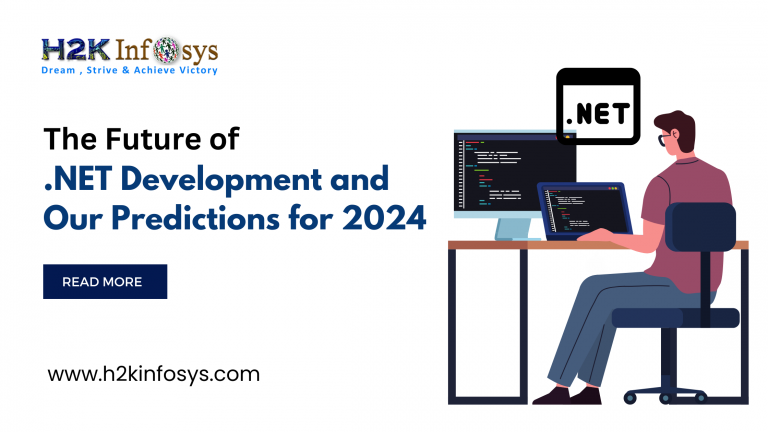In the dynamic field of .NET development, a fundamental query emerges: What are the trends influencing software innovation? Microsoft’s mainstay, the .NET framework, remains steadfast in this dynamic environment, providing developers with an adaptable toolkit.
The Common Language Runtime (CLR) and Framework Class Library (FCL) provide strong memory management and web development is revolutionised by .NET. It smoothly combines Web Pages’ quick application development, Webforms’ increased control, and MVC’s natural workflow, giving developers the tools they need to prepare for a dynamic digital future.
Come along on this exciting journey as we uncover the trends that the .NET ecosystem will be seeing in 2024 and disclose the mysteries that point to an exciting future for software development. To learn more, check out the .NET training online.
The Growth of .NET Development
Since its launch in 2002, Microsoft’s .NET development has experienced substantial changes. After being limited to the Windows operating system, .NET has expanded and is now compatible with various other operating systems. The versatility of the framework has been a major factor in its broad adoption by developers worldwide.
The Impact of .NET Development: A Statistical Perspective
A statistical analysis of .NET development reveals its pervasive influence. According to data from Statista, roughly 25.3% of participants chose the .NET (5+) Framework, whereas roughly 17% chose the .NET Framework (1.0 – 4.8). Because of the increased demand for .NET-based solutions, unemployment rates have dramatically decreased and a wide range of professional options are now available to people with different levels of education. This pattern emphasises how important .NET is to advancing both technology and economic prosperity.
.NET Development: A Glimpse into the Future Ahead
The most recent version, .NET 6.0, provides applications with stability and robustness as of 2022. Because of Microsoft’s dedication to continuous support, developers may easily incorporate .NET 6.0 components into their current applications. In the future, the upcoming .NET 7.0 version is expected to include additional improvements, such as:
1. AOT Compilation and Profile-Guided Enhancement
In order to improve startup performance, code is translated into machine language ahead of time (AOT) compilation. Profile-guided optimization enhances overall efficiency by optimising code execution pathways using profile data. AOT compilation, for example, can improve the code in a weather app to get real-time data, assuring prompt updates when users open the app.
2. FileStream Upgradation
FileStream is essential to actions involving input and output. Upgrading it entails improving user experiences and performing file operations with ease. For a cloud-based document editor, faster uploads, downloads, and edits are guaranteed with enhanced FileStream. Users may work together on paper with ease, creating a productive atmosphere.
3. Crossgen2 Implementation
Crossgen2 improves efficiency by speeding up application loading times. Crossgen2 streamlines the program loading process when a user opens it. Take an online shopping platform as an example. With quicker loading times, customers can browse products and make purchases more quickly, which increases customer happiness and boosts revenue.
4. Hot Reload Functionality
This feature enables real-time changes by letting developers edit code while the program is running. Developers can modify game mechanics in a gaming application without interrupting gameplay. The smooth gameplay experience that is ensured by this dynamic adjustment facilitates developers in fine-tuning user interactions.
5. .NET MAUI Advancements
Applications may function seamlessly across a variety of platforms thanks to .NET MAUI. For instance, .NET MAUI guarantees identical user interfaces across Windows, iOS, and Android devices in a messaging app. No matter the device, users can communicate easily, creating a consistent experience and increasing user retention.
Predictions for .NET Development Trends in 2024
1. ML.NET 1.4: Enabling Intelligent Applications
Across all industries, machine learning (ML) has emerged as a key area of innovation concentration. Within the field of .NET development, Microsoft’s dedication to innovative solutions is exemplified by ML.NET 1.4. With the help of this open-source machine learning framework, developers can easily design custom machine learning models, which improves their ability to produce one-of-a-kind solutions.
As an example, consider an e-commerce site that analyses consumer behaviour patterns using ML.NET. By using deep learning algorithms, the platform can make product recommendations that are specific to each user’s tastes, improving user experiences and increasing revenue. Additionally, ML.NET can identify anomalous transaction patterns in the banking industry to detect fraud, protecting users’ online transactions.
2. Blazor Framework: Revolutionising Interactive Web Development
Blazor depends on JavaScript and is easily integrated with C#. It lets programmers use C# to create interactive user interfaces. Imagine a Blazor-built healthcare management system.
Example: Using a dynamic, responsive interface, medical practitioners may interactively access patient records, adjust treatment plans, and make appointments. Blazor is essential to the construction of contemporary online applications since it allows developers to save time and enhance user experience by reusing web components.
3. Xamarin Development: Unifying Cross-Platform Applications
The cross-platform technology stack Xamarin helps to reduce the complexity. With a single code base, developers can ensure native performance on a variety of platforms.
Consider a Xamarin travel app that can be used on a variety of devices. It promotes user engagement and pleasure by saving time and providing a uniform user interface and functionality. Because of its adaptability to new platforms, Xamarin is a great option for companies looking to reach a wide audience.
4. ASP.NET Core Docker Support: Embracing Scalable Microservices Architectures
Microsoft’s initiative towards openness and creativity has been bolstered by the shift toward an open-source software development culture, as seen by the success of ASP.NET Core. The Docker support integration in ASP.NET Core makes it possible to deploy apps using a microservices architecture.
Example: Assume that Docker and ASP.NET Core are used to deploy a cloud-based banking application. For certain banking operations, such as transactions, account management, and customer assistance, each microservice runs on its own. One service can grow on its own without harming other services in the event of excessive demand, guaranteeing peak performance and user satisfaction.
Conclusion.NET is a symbol of stability and innovation. Its transformation from a Windows-only framework to a multiplatform powerhouse is a testament to its flexibility and durability. The future of .NET development seems promising as long as developers keep utilising cutting-edge technologies like ML.NET, Blazor, Xamarin, and Azure Kubernetes Service. Because of Microsoft’s steadfast dedication to maintaining and improving the framework, .NET developers can use it with confidence as the foundation for their digital projects. Check out the online .NET course to learn more.






























